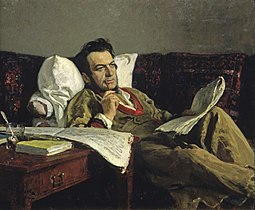
Glinka was born in a small village near Smolensk in 1804 and died 53 years later in Berlin. His honorary title ‘fountainhead of Russian classical music’ is a bit much, but Glinka was indeed the first Russian composer who could compete with his famous western colleagues. The Glinka method was to sprinkle typical Russian elements over western templates. Glinka received a very western-orientad education. Even though he did receive his education in St. Petersburg first, this training was modelled in a western manner. Then, Glinka travelled through Europe and stayed in Milan and Berlin.
Glinka was part of the upper class, his music reflected that. The song and chamber music were part of the aristocracy; they liked to listen to short pieces in the living room with comprehensible shapes, simple harmonies, and a splash of sentimentality. Glinka capitalised on that by combining German style with an Italian sense of bel canto. This eventually led to his most famous pieces of music: the operas Ruslan and Ludmilla and A Life for the Tsar. These works were immediately included in the Russian standards catalogue, which only changed after the shift in power in 1917. An ode to the tsar wasn’t a good idea in Russia after 1917, but the music was way too popular to ignore. Now what? As a compromise, they changed the title to Ivan Susanin, an alternative title from Glinka himself. Susanin led the Russian army that beat a Polish invasion army in 1613. That’s how A Life for the Tsar endured the censorship of the new rulers; even communists have a flexible conscience, sometimes.
Have a go at Glinka
Listen From Thursday 1 April 2021, from 4 to 5 pm.








